Home > Products > DURANEX(R) PBT
Resin materials suited to high-voltage automotive environments
Resin materials suited to high-voltage automotive environments |
|---|
| 1. Introduction |
The environment surrounding the automotive industry is undergoing drastic change, and people are starting to want different things from their cars. Design, fuel economy, option packages and such had traditionally been the criteria for choosing a car, but now CASE (Connected, Autonomous, Shared & Service, Electric) is expected to be a critically important keyword in the car selection process. Electrification is particularly likely to gain additional traction due to efforts under way in countries around the world to reduce the use of fossil fuels and get tougher on emissions.
Resin materials help facilitate weight reduction in cars while also offering insulation properties, so usage of resin materials in car parts could increase along with progress in electrification. Typically, PA66 and PBT are often used as resin materials for their constant mechanical properties and chemical resistance in the range of temperature environments required for cars, between -40℃ and 140℃. Each of these two materials has its own characteristics, and they are both in stable supply. These days we see an increasing number of usage cases for PBT. Here, we compared the electrical properties of these two materials on the assumption of use in high-voltage parts and considered what each is suitable for. |
| 2. High-Voltage Parts |
The most important parts for electric cars (including HEVs and PHEVs) are broadly classified as batteries, power control units (PCUs), and motors/generators. Each of these parts has the functions of control, electricity storage, driving, and regeneration. These parts are connected electrically in high-voltage harnesses with electricity of between 300V and 600V flowing between them, and resin materials are used in the insulation portion of each of the parts. The resin that is used in these parts must have both the electrical properties not to cause any problems even when used in high-voltage environments, and the mechanical properties, dimensional accuracy, heat resistance, chemical resistance, and other such properties that have conventionally been required of car parts. |
| 3. Resin Materials Suitable for High-Voltage Parts |
We evaluated PBT-GF30% and PA66-GF33% which are typically used in high-voltage connectors, terminal blocks, and other such parts. Below are the materials that we compared.
(Materials evaluated) • DURANEX® PBT CG7030 (PBT-GF30%) / For high-voltage applications, high-voltage connectors, etc. • DURANEX® PBT 531HS (PBT-GF30%) / For products including metal inserts, busbars, etc. • DURANEX® PBT 330HR (PBT-GF30%) / For typical parts • PA66-GF33% / For typical injection molding |
| ■ Mechanical Properties |
Figure 1 shows the temperature dependency of the tensile strength of each material, while Figure 2 shows changes in tensile strength when maintained in hot, moist environments. For temperature dependency of tensile strength in an absolute dry state (Figure 1), |
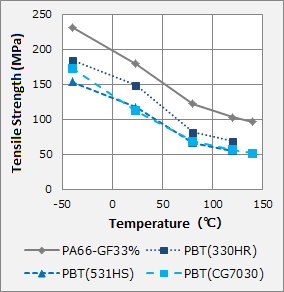 |
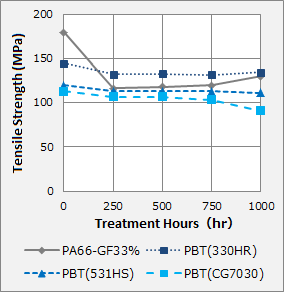 |
Figure 1 : Temperature dependency of tensile strength (absolute dry) |
Figure 2 : Tensile strength after heat and moisture treatment |
|---|
| ■ Dimensional Accuracy |
Each car is an ensemble of parts, and it is critically important that cars are mass produced while maintaining the dimensional tolerance of the parts without any variation. Depending on the type of resin material, moisture absorption can cause larger dimensional changes which can impact the dimensions when the parts are used. Figure 3 shows moisture absorption rate, while Figure 4 shows dimensional change rate in the transverse direction (TD) to the flow. The test piece used for the evaluation was a multipurpose dumbbell test piece which was measured after being left in the 85℃/85%RH environment for the specified amount of time. As you can see in Figures 3 and 4, PA66-GF33% has high initial moisture absorption rate, which results in a higher rate of dimensional changes. On the other hand, both moisture absorption rate and dimensional change rate for PBT grades are around one-tenth of the values observed for PA66-GF33%, from which we can see that these are highly superior in terms of dimensions. |
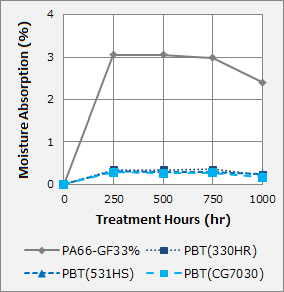 |
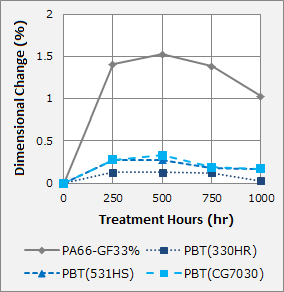 |
Figure 3 : Moisture absorption rate |
Figure 4 : Dimensional change rate (in a transverse direction to flow) (TD) after heat and moisture treatment |
|---|
| ■ Dielectric Breakdown Properties |
One particular characteristic required of materials used in high voltage is dielectric breakdown strength. Since resin materials have insulation properties, they cannot normally conduct electricity even when bearing a certain amount of voltage. However, when voltage equal to or greater than the dielectric breakdown strength of the materials is applied, it causes dielectric breakdown and the current is then conducted. Here, we evaluated the dielectric breakdown strength for each sample before (untreated) and after (85℃/85%RH, after 1,000 hours) heat and moisture treatment. The results are shown in Figure 5. There was no major difference in dielectric breakdown strength between the PBT grades and PA66-GF33% in the untreated sample. On the other hand, we see a major decline of around 40% only in PA66-GF33% after heat and moisture treatment. As explained above, PA66 has a high moisture absorption rate, which points to the possibility that dielectric breakdown strength declined due to moisture absorption. |
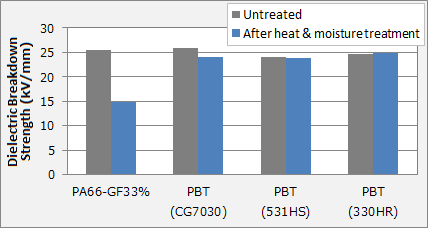 |
Figure 5 : Dielectric breakdown strength after heat and moisture treatment |
|---|
| ■ Volume Resistivity |
Volume resistivity is one index to measure the insulation properties of resin materials. Typical resin materials have volume resistivity of around 1015 Ω • cm. Figure 6 shows volume resistivity measurement results before (untreated) and after (85℃/85%RH, after 1,000 hours) heat and moisture treatment. Untreated PA66-GF33% and PBT (CG7030) both show volume resistivity of 1015 Ω • cm or higher, but PA66-GF33% shows a tendency for volume resistivity to significantly decline in heat and moisture. |
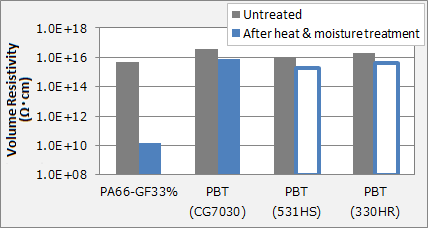 |
|
|
|
Figure 6 : Volume resistivity after heat and moisture treatment |
|---|
| ■ Tracking resistance |
Tracking is a phenomenon that occurs when the surfaces of insulation materials carbonize and form conducting paths when voltage is applied, causing the surfaces to erode and conduct electricity continuously. Comparative tracking index (CTI) is an index that shows resistance to the occurrence of tracking and erosion. For CTI we also compared PA66-GF33% and PBT. The results are shown in Figure 7. The maximum value for CTI is 600V. Both PA66-GF33% and PBT (CG7030) showed results of 600V when untreated. After heat and moisture treatment, PBT (CG7030) had a slight decrease in CTI. PA66 did not decline because its molecular structure is resistant to tracking and erosion. CTI for PBT (CG7030) declines somewhat in hot, moist environments, but we anticipate that this property can be compensated for with greater creepage distance. |
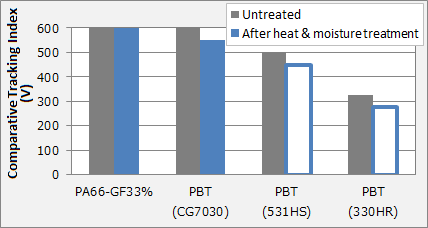 |
|
|
|
Figure 7 : Comparative tracking index (CTI) after heat and moisture treatment |
|---|
| 4. Summary |
To summarize, Table 1 shows the properties typically required for the hot, moist environments in which car parts are used. In design it is generally hard to cover up for the insulation-related properties of resin materials such as dielectric breakdown and volume resistivity, and since the properties of PBT grades experience little change even in hot, moist environments, we can determine that they are more suitable than PA66 for use in high-voltage environments. These results suggest that using PBT could produce less variation in electrical properties when environments change. Choice of this material might be considered depending on the usage environment for new parts as the shift toward electrification progresses. |
Table 1 : Comparison of resin materials for high voltage resistance |
Item |
PBT |
PA66 | ||
330HR |
531HS |
CG7030 |
— |
|
GF30% |
GF30% |
GF30% |
GF33% |
|
Tensile strength |
+++ | ++ | ++ | +++ |
| Dimensional change | +++ | +++ | +++ | + |
| Dielectric breakdown | (+++) | (+++) | +++ | + |
| Volume resistivity | (+++) | (+++) | +++ | + |
| CTI | + | ++ | +++ | +++ |
※ Performance criteria: +++ (good) > + (bad) |
[Related information] |
Technical data sheet is |
|
||
For inquiries about our |
◆Polyplastics Group Representative | ||
| ◆WEB Inquiry |
28th February 2020 |

